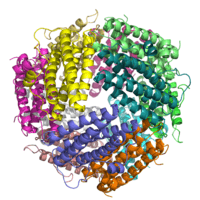DPS
DPS may stand for:
Schools
Politics and government

DNA-binding protein from starved cells
DNA-binding proteins from starved cells (DPS) are proteins that belong to the ferritin superfamily and are characterized by strong similarities but also distinctive differences with respect to "canonical" ferritins.
DPS proteins are part of a complex bacterial defence system that protects DNA against oxidative damage and are distributed widely in the bacterial kingdom.
Description
DPS are highly symmetrical dodecameric proteins of 200 kDa characterized from a shell-like structure of 2:3 tetrahedral symmetry assembled from identical subunits with an external diameter of ~ 9 nm and a central cavity of ~ 4.5 nm in diameter. Dps proteins belong to the ferritin superfamily and the DNA protection is afforded by means of a double mechanism:
The first was discovered in Escherichia coli Dps in 1992 and has given the name to the protein family; during stationary phase, Dps binds the chromosome non-specifically, forming a highly ordered and stable dps-DNA co-crystal within which chromosomal DNA is condensed and protected from diverse damages. The lysine-rich N-terminus is required for self-aggregation as well as for Dps-driven DNA condensation.

PictBridge
PictBridge is a historical computing industry standard introduced in 2003 from the Camera & Imaging Products Association (CIPA) for direct printing. It allows images to be printed directly from digital cameras to a printer, without having to connect the camera to a computer. Its formal name is "Standard of Camera & Imaging Products Association CIPA DC-001 — 2003 Digital Solutions for Imaging Devices". CIPA DC-001-2003 Rev. 2.0 has been published in 2007.
PictBridge is typically implemented using Universal Serial Bus ports and the USB protocol. PictBridge-capable printers typically have a USB Type A receptacle which is then connected by cable to the USB port of a PictBridge-capable digital camera (typically a Type Mini-B). The user selects the images on the camera, which the printer retrieves and prints.
PictBridge arguably does not qualify as an open standard, as the specification can only be obtained from CIPA after agreement not to disclose any information from the specification to others (section 2.2 of the agreement). In practice, this means that PictBridge cannot be implemented as free software or open source software, other than by reverse-engineering the protocol (perhaps aided by the white paper that CIPA provides), if publishing source code of an implementation of the PictBridge standard is considered to count as "disclosing information" from the specification.


